Porcelain Insulator News
by Elton Gish, NIA #41
Reprinted from "Crown Jewels of the Wire", April 1989, page 22
In the Porcelain Insulator News column which appeared in the December, 1988
issue of CJ, we asked for help in identifying the "whatisit" that looked
like a mushroom. To refresh your memory, we will show the drawing of this one
again. My specimen has a mottled black and tan glaze similar to Ohio Brass or
Thomas, with 1-5/8 inch segmented threads. Since the insulator does not have a
wire groove, it must have a very special purpose.
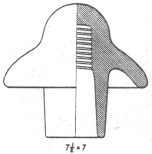
Our appeal for help in identifying this oddity did not go unnoticed. Three
collectors have offered their help. While some doubts do exist to the exact use
of this insulator, we do have a good idea what may have been the intended
purpose.
Alan Drew suggested that it may have been used to support an insulator
switching platform similar to that shown in a photo from his files (see photo
below). He said that it was common practice in the early days to insulate the switchman
from grounding potential. Substations would have several of these small
switching platforms, many of which were supported by multipart insulators. The
wooden platform would have circular recesses cut in the wood which would have
allowed it to set firmly on top of four pin type insulators. While this is a
possible use for the "mushroom", it would appear difficult to secure
the wooden platform to the curved top of the insulator.
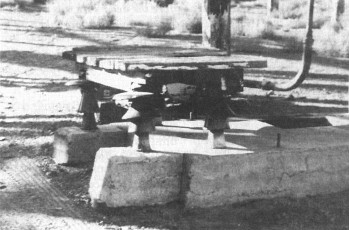
Vincent Yeasted sent the photograph shown below of a metal bar with one of
these exact mushroom-shaped insulators attached to each end of the curved bar.
He said that this metal horn device was attached to the end of a suspension
string by a ball socket and the conductor cable was then attached to the metal horn. He suggested that the device may
have been used to dampen the line vibrations. While I cannot understand how this
device could dampen mechanical vibrations of the conductor since it was attached
at the suspension string, it did ring a bell in the back of the ole memory
banks.
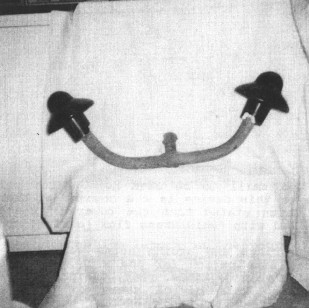
I searched through all the old manufacturer catalogs in my collection and
finally found one photograph from the 1926-27 Ohio Brass catalog. This photo
(see top of the next page) probably will not reproduce very well since the
catalog photo was on thin paper allowing the images from the other side of the
page to show through. A horn device, identical to the one in the photo that
Vincent sent with a "mushroom" insulator attached on each end, is
clearly seen in the original photo, although probably too small to be seen here. The only catalog reference to this device
is the comment at the bottom of the page which stated that the tower in the
photograph was installed with "Ohio Brass flux [corona] controls".\
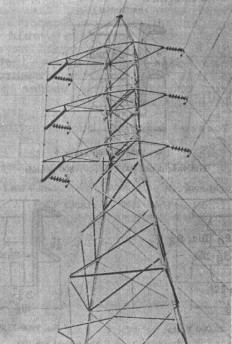
Arcing rings and arcing horns were very prevalent during that time period for
use with suspension strings on very high voltage lines. But, the porcelain
insulator arrangement on this device seems to me to be quite different in that
the ends of the horn are porcelain rather than metal. The all metal arcing horns
provided a point of arcing around the insulator string for a surge of current
(lightning), thus preventing overloading and damage to the insulators. Then why
the use of porcelain insulators on the ends of the horn? The insulator would
surely be damaged from the arc. Perhaps this idea did not work very well. Other
companies relied on all metal arcing horns and rings of various designs.
Ken Stefan sent what may be another use. He said that he had a magazine or
catalog which showed this same mushroom-shaped insulator in use on a small
loading coil. But, after much searching, he could only come up with a photograph
of a larger coil. The photo at the top of the next page is the one Ken sent from
the 1925 Ohio Brass catalog. Ken said that these loading coils were used in
radio service. Note the larger, possibly two-piece, insulators attached to the
ends of the support rods on top of the coil. The insulators in the photo, as with the
"mushroom", do not appear to have a wire groove. Ken believes that the
insulators were used to combat the effects of corona since it is obvious from
the large vertical insulators at the bottom of the coil that this device
operated at very high voltages.
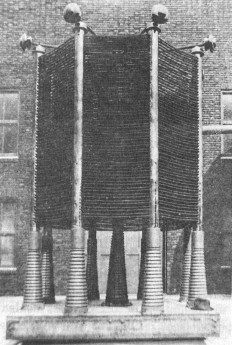
While we have yet to find definite evidence or explanation of the specific
use of this "whatisit", it is very likely that it was used in an
effort to combat the effects of corona in very high voltage service. Ohio Brass
was evidently the manufacturer of this item sometime during the 1920's. The
effectiveness in suspension service may have been in question as Ohio Brass
catalogs do not mention this device in detail. Hopefully, Ken will find more
information on the mushroom that will clear up any doubts we may have.
| 